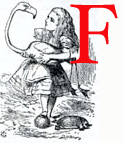[The illuminated “F” is based on one of John Tenniel's illustrations for Alice in Wonderland — George P. Landow.]

our years before [James Anthony Froude's] The Nemesis of Faith and two years before "The Spirit's Trials," Miss Jewsbury had published her own novel of doubt, Zoe: the History of Two Lives (1845), perhaps the first serious effort to deal with the subject in fiction. "Modesty and reserve" are wholly absent from Zoe, set in the eighteenth century and dealing with a handsome married woman, a friend of Dr. Johnson and his circle (all of whom appear), who falls in love with a Catholic priest, Everhard Burrows. But Everhard is not just an ordinary Catholic priest: he is a friend of the eighteenth-century sceptics in both France and England, has taken priestly orders with no profound conviction, and thereafter grows steadily more convinced that the evidence for the truth of Christianity is unsatisfactory. Questioning the truth of revelation, he finds himself "in utter ignorance, without a hope or a belief to guide him." . . .
But before Everhard had abandoned the priesthood, he had fallen in love with Zoe. He has never told her so until the night he rescues her from a fire. "A warm palpitating weight," she lies on his bosom (she is in her nightdothes at the time), and soon he "who had never touched a woman" experiences a "whole life of passion" in a single moment. "He crushed her into his arms with ferocious love,—he pressed burning kisses upon her face, her lips, and her bosom; but kisses were too weak to express the passion that was in him. It was madness like hatred, — beads of sweat stood thick on his forehead, and his breath came in gasps." At once, Zoe's own "burning arms were round his neck, and her long hair fell like a veil over him." After a few moments of "delirium," Zoe recovers first, and the love affair between Zoe and Everhard harks back to such famous "Gothic" novels as M. G. Lewis's The Monk (1796), in which Catholic monks or priests press unwelcome sexual attentions on fair young women, usually in a vaulted chapel. The only difference is that Zoe welcomes Everhard's embraces (which also take place in a chapel, immediately before the altar). In all other respects Zoe is a truly pioneering effort. It is the first novel to sound the notes which novelists were so often to repeat. Scepticism of Christian evidences, sublimation of doubt in sex, social service among the poor as a substitute for faith, the importance of German biblical criticism in undermining belief: all these—entirely new in 1845—we shall encounter again and again in the more famous novels of doubt that we shall be examining. Mrs. Humphry Ward, whose Robert Elsmere (1888) became the classic of the subject more than forty years after Zoe, includes all ot these elements except for the sexual: and that, together with all the rest, is a marked feature of the five extraordinary novels of W. H. Mallock, the last of which, published in 1899, brought the century to an end.
Little wonder that, despite its glaring faults, Zoe struck Jane Carlyle with a "feeling little short of terror! So much power of genius rushing so recklessly into unknown space!" She added that the "old and young roues of the Reform Club almost go off into hysterics over its indecency." Though Zoe did not even have "a fig-leaf of conformity," though its publisher was deeply worried about its outspokenness, and though its reviewers protested against its "fling at the reasonableness as well as the purifying influence of the Christian faith" or found it — quite rightly — "feverish" or "most dangerous," it made a great noise. . . . [T]he doubts that Everhard felt about Christian evidences were Geraldine Jewsbury's own, even as early as 1845. . . [Zoe is] a kind of autobiography. [403-05]
Bibliography
Wolff, Robert Lee. Gains and Losses: Novels of Faith and Doubt in Victorian England. New York and London: Garland, 1977.
Last modified 5 July 2014